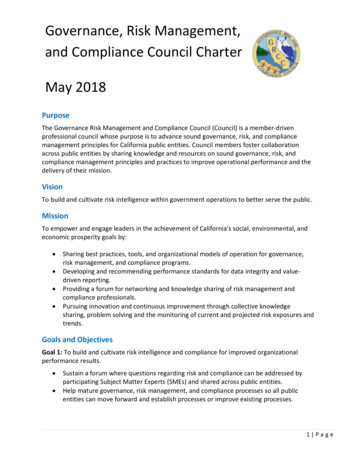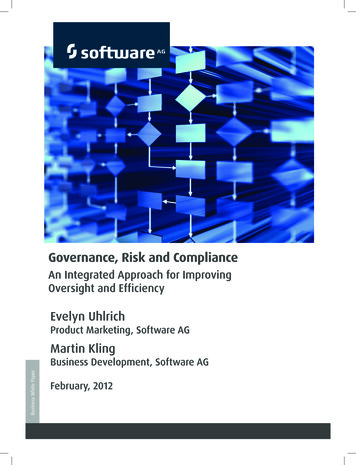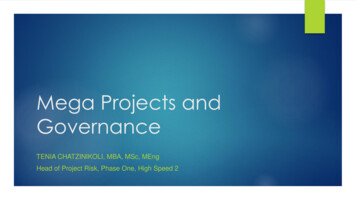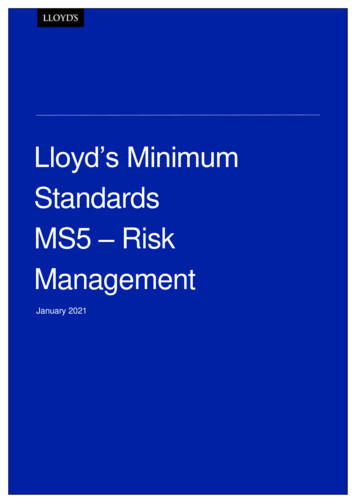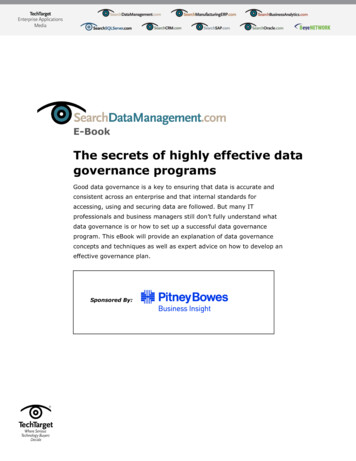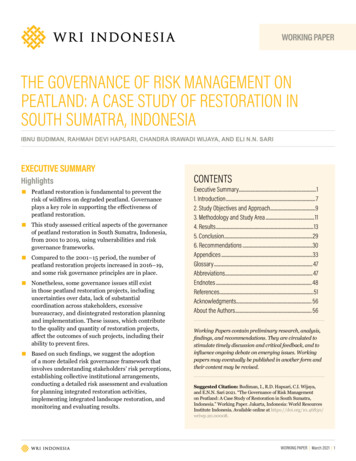
Transcription
WORKING PAPERTHE GOVERNANCE OF RISK MANAGEMENT ONPEATLAND: A CASE STUDY OF RESTORATION INSOUTH SUMATRA, INDONESIAIBNU BUDIMAN, RAHMAH DEVI HAPSARI, CHANDRA IRAWADI WIJAYA, AND ELI N.N. SARIEXECUTIVE SUMMARYHighlights Peatland restoration is fundamental to prevent therisk of wildfires on degraded peatland. Governanceplays a key role in supporting the effectiveness ofpeatland restoration.This study assessed critical aspects of the governanceof peatland restoration in South Sumatra, Indonesia,from 2001 to 2019, using vulnerabilities and riskgovernance frameworks.Compared to the 2001–15 period, the number ofpeatland restoration projects increased in 2016–19,and some risk governance principles are in place.Nonetheless, some governance issues still existin those peatland restoration projects, includinguncertainties over data, lack of substantialcoordination across stakeholders, excessivebureaucracy, and disintegrated restoration planningand implementation. These issues, which contributeto the quality and quantity of restoration projects,affect the outcomes of such projects, including theirability to prevent fires.Based on such findings, we suggest the adoptionof a more detailed risk governance framework thatinvolves understanding stakeholders’ risk perceptions,establishing collective institutional arrangements,conducting a detailed risk assessment and evaluationfor planning integrated restoration activities,implementing integrated landscape restoration, andmonitoring and evaluating results.CONTENTSExecutive Summary.11. Introduction.72. Study Objectives and Approach.93. Methodology and Study Area.114. Results.135. Conclusion.296. tions.47Endnotes. 48References.51Acknowledgments. 56About the Authors. 56Working Papers contain preliminary research, analysis,findings, and recommendations. They are circulated tostimulate timely discussion and critical feedback, and toinfluence ongoing debate on emerging issues. Workingpapers may eventually be published in another form andtheir content may be revised.Suggested Citation: Budiman, I., R.D. Hapsari, C.I. Wijaya,and E.N.N. Sari 2021. “The Governance of Risk Managementon Peatland: A Case Study of Restoration in South Sumatra,Indonesia.” Working Paper. Jakarta, Indonesia: World ResourcesInstitute Indonesia. Available online at https://doi.org/10.46830/wriwp.20.00008.WORKING PAPER March 2021 1
BackgroundBetween 1997 and 2015, Indonesia’s devastatingpeat fires recurred due to the absence of strongpolicies and effective government for peatlandrestoration. During this period, the fires released 0.7gigatons of carbon (GtC) emissions and exacerbatedclimate change. These hazards raised concerns aboutfire risk management on peatland. In 2016, theGovernment of Indonesia (GoI) established the PeatlandRestoration Agency (Badan Restorasi Gambut; BRG)to support the Ministry of Environment and Forestry(Kementerian Lingkungan Hidup dan Kehutanan;KLHK) in scaling up peatland restoration projects asrisk management efforts on the country’s peatlands.Peatland restoration consists of activities such as soilrewetting, revegetation, and livelihood revitalization forpeat-based communities. This program has been donein seven priority provinces, including South Sumatra.However, this restoration effort is hampered due toa poor governance system, which involves excessivebureaucracy and a lack of coordination among theBRG, KLHK, and local governments (Kartodihardjo etal. 2018). Due to this lack of coordination, restorationplanning and implementation were not integratedwithin the peatland hydrological unit (PHU) as peatlandlandscape; this may influence the effectiveness andimpact of peatland restoration activities (Kartodihardjoet al. 2018; KPRGSS 2018).and leads to unintended impacts, such as wildfires,on peatland. These impacts are known as materialvulnerabilities. Governance reform, such as better datafor planning, suitable institutional arrangements, andmore coordination and enforcement in implementation,is needed to stop these vulnerabilities. These topicsare included in the risk governance framework as astrategy to cope with the uncertainties inherent incomplex socio-environmental actions such as peatlandrestoration. The risk governance framework coversaspects within the governance cycle—from planningto implementation and monitoring. It includesevaluating policy and governance practices that causevulnerabilities, understanding stakeholders’ perceptionsof risk, creating robust institutional arrangements,assessing and evaluating risks, implementing riskmanagement, monitoring, and communicating andcoordinating all aspects.By using those frameworks, we evaluatedthe governance of peatland restoration anddeveloped recommendations for improvingrisk governance strategies to prevent fires. Weoffer a new direction for peatland stakeholders—suchas the government, plantation companies, and civilsociety groups—to improve the performance of policiesand peatland governance in Indonesia, and perhaps inother tropical countries, to support sustainable peatlandmanagement to mitigate climate change.About This PaperKey FindingsThis study assessed critical aspects in thegovernance of peatland restoration in SouthSumatra and its possible impacts. This provincehas experienced dynamic land-use change and fireson its 1.2 million hectares (ha) of peatlands since1997. Our study draws on qualitative, spatial, andquantitative data; interviews with key stakeholders;direct observation; academic literature; experimentalmodeling; open data platforms; and reviews of policyand project reports. These data were analyzed withthe help of theoretical frameworks describing thevulnerabilities and risk governance strategies (Giesenand Sari 2018; Renn 2017; Simon and Dooling 2013).Although a few peatland restoration projectshad been initiated in South Sumatra since2001, they were small compared to the extent ofpeatland that was converted to concession areasbetween 2003 and 2010. The restoration activitiesduring the 2000s were conducted by nongovernmentalorganizations (NGOs) and a government researchinstitute in a few villages in two regencies, but theimplementation was fragmented among differentprojects, actors, and designs and thus had low impact.Between 2003 and 2010, 320,000 ha of burnedpeatland was converted to oil palm plantations,1 and12 logging concessions2 were established on 485,552ha of peatland (KLHK 2018; Koh et al. 2011). This landconversion involved drainage activities that contributedto the continuing degradation of peatlands andincreased their vulnerability to fires. In 2006–08, firesoccurred on 301,454 ha of peatland. In 2011, the GoIissued a moratorium for business permits on peatland.Vulnerabilities exist in political and materialforms; thus, risk governance is needed. Politicalvulnerability is the inability of policymakers andstakeholders to deal with the complexity of governancethat often results in poorly judged interventions2
The Governance of Risk Management on Peatland: A Case Study of Restoration in South Sumatra, IndonesiaHowever, the moratorium was not fully implemented,and during the 2015 El Niño, fires recurred on between117,367 and 144,410 ha of peatland in the province. Thisshows a high political vulnerability that contributed torecurrent material vulnerabilities.In 2016, the government targeted 656,884 haof peatland in South Sumatra for restorationby 2020, mostly located in concession areas.This target is part of the national peatland restorationprogram by the GoI. This program is facilitated by theKLHK and the BRG. Peatland restoration activitiesin concession areas are governed by the KLHK andconcession holders; activities in nonconcession areas aremanaged by the BRG and provincial governments.The authors found that peatland restorationprojects that adapted a few risk governanceprinciples increased significantly between2016 and 2019. This is largely thanks to the nationalpeatland restoration program, which improvedpolicymakers’ understanding of fire risk and thevulnerability of degraded peatlands. The GoI found thatdrainage activities further degraded peatlands, makingthem prone to fires and in need of restoration. Thenational restoration program brought more resources.The national and provincial government worked withNGOs, communities, and concession holders to conducta risk assessment and evaluation to help them planrestoration activities over wider areas.However, some critical issues were found in thegovernance of peatland restoration, particularlyin 2017–18. These issues are considered politicalvulnerabilities in the practice of peatland restorationin the province, and they contributed to materialvulnerability during the 2019 El Niño year. Interactionsand feedback among the stakeholders involved in thoseissues are set out in Figure ES-1.First, the effectiveness of restoration planningand implementation was impacted by a lackof both accurate risk assessment and effectivecommunication among peatland restorationstakeholders. A detailed risk assessment is requiredto understand the priorities and location for peatlandrestoration, and accurate, updated peatland data isimperative. Unfortunately, South Sumatra lacked suchdata in 2017. This issue seriously affected the overallresult of restoration activities and was exacerbated bydifferent perceptions and poor communication betweenthe BRG and provincial governments. This hamperedthe implementation of more than 5,000 restorationactivities in 2017. In 2018, although the peat dataaccuracy was addressed, necessary restoration activitiesdid not occur in some peat areas. Also, a lack of standardenforcement in implementation led to technologicalissues and mistargeted aid. By the end of 2018, peatlandrestoration implementation in nonconcession areasachieved about 10 percent of the provincial target.Second, restoration progress has been slow inconcession areas due to excessive bureaucracy,and peatland continues to be converted toconcessions. Restoration in concession areas requiresconcession holders to go through a lengthy process withthe KLHK. Although the BRG had provided technicalassistance about restoration to concession holders, itwas not enough to speed up the progress of restorationbecause implementation relies on approval by theKLHK. Besides, there was lack of substantial integrationbetween the BRG’s role in providing technical assistanceand the KLHK’s authority to approve concessionholders’ restoration plans. As of 2018, the KLHK had yetto approve any official restoration plans for concessionholders in South Sumatra; nonetheless, some concessionholders were moving ahead with restoration activities.Meanwhile, between 2015 and 2018, other concessionholders continued to convert peatland3 (78,607 ha/year4) to oil palm plantations (YMB 2020) despitethe moratorium policy on peatland conversion. Weakenforcement of the moratorium policy contributedto continued peatland conversion. This sustained thedrivers of peatland degradation in the province.Third, there was a lack of collective action forconducting landscape restoration that coversconcession and nonconcession areas. This wascaused by the absence of any substantial coordinationamong peatland restoration stakeholders to planand implement an integrated restoration in the samelandscape/PHU. Integration between restorationin villages and concession areas was also lacking.This might have been caused by the structure of theinstitutional arrangement, which divided restorationresponsibility between concession and nonconcessionareas, in different organizations, without a propercoordination mechanism.WORKING PAPER March 2021 3
Those three governance issues are consideredpolitical vulnerabilities where policymakersand stakeholders have yet to deal withthe complexity of restoration governance.Overall, these issues have contributed to low targetachievement and poor implementation of restoration.They reduced the effectiveness of the restorationprogram and led to unintended impacts during theEl Niño year. During the El Niño, the dry season wasthree to four months longer, and it made unrestoredpeatlands more prone to wildfires. These situationsbrought material vulnerability.These political vulnerabilities resulted ingreater peatland fires during the 2019 El Niño.Between 139,084 and 174,341 ha of peatland burned,emitting 0.049–0.062 GtC (KLHK 2020; UMD n.d.).About 70 percent of fires occurred in new areas.Seventy-six percent of these newly burned peatlandswere found in concession areas that included newconcessions converted in 2015–18. Another 30percent were located in areas that also burned in2015–18. These burned areas included some areaswhere restoration activities were planned and/orimplemented.4 These findings suggest that peatland conversion toconcessions must cease, restoration in concessionareas must be accelerated, and governance mustbe improved to increase the impact of restorationefforts. Some improvements have been made. In2018–19, with an NGO consortium consisting of WorldResources Institute Indonesia, World Agroforestry, andWetlands International Indonesia, the BRG arrangeddetailed annual restoration plans for 14 PHUs in SouthSumatra. These plans include stakeholder analysis inthe PHUs. This helped to more accurately implementrestoration in the province in 2019. In addition, the BRGand its partners also established an online monitoringplatform5 to measure the progress of restoration activitiesand evaluate their impacts. These actions have adaptedmore aspects within the risk governance framework.
The Governance of Risk Management on Peatland: A Case Study of Restoration in South Sumatra, IndonesiaFigure ES-1 The Governance of Peatland Restoration in South Sumatra, 2016–19Peatland Hydrological Units/PHUsConcession AreasNonconcession Areas2016PP 57/2016 (amendment) on the protection of peatland ecosystemNational government peatland restoration program:rewetting, revegetation, livelihood revitalizationContingency plan for peatland restorationImplementation rate: 4%, only 10 rewetting20172017Letter to restore peat sent to 20companiesNew governance arrangement(local participation and revised budget scheme)and local regulations on peatland management20182018Companies made restorationReviewed by KLHKPeatconversionto oil palmplantationsNo plan approved,no proper restorationimplementedRapid assessment of contingency planImplementation: 10%, 657 rewetting, but lowaccuracy/mistargeted, lack of enforcement totechnological standard, lack of revegetation andintegration among activities and with activities inconcession areaFew companies installed canalblocking with local partnersNo integration among restoration activitiesin companies and with activitiesin nonconcession areaNo PHU-based restoration implementedDetailrestorationplanningcreated in14 ying andreducingrestorationimplementationPemanent ban for business permit on peatlandFires in139,084 ha peatPHU-based restorationis planned2020Political/policy (vulnerability)Risk governanceMaterial vulnerabilityNote: KLHK Kementerian Lingkungan Hidup dan Kehutanan (Ministry of Environment and Forestry); PP Peraturan Pemerintah (Government Regulation).Source: WRI Indonesia authors.WORKING PAPER March 2021 5
RecommendationsTo further improve governance of peatland,a more detailed risk governance strategy thatconsiders both biophysical and socioeconomicaspects of the ecosystem is needed. This strategymust reflect specific functions, such as detailedrisk assessment, monitoring tools, effective riskcommunication, and deliberative participation. It aimsto develop a structure that is better suited to cope withfire risk from degraded peatlands and the increasedfrequency of El Niños. This risk governance strategyshould involve multiple stakeholders in the decisionmaking process to enable the creation of mutualagreement procedures/mechanisms and to supportknowledge/technology transfers.Table ES-1 The risk governance strategy can helppolicymakers and stakeholders cope with multipleuncertainties, such as technoscientific knowledge,institutional strategy, and politics in peatlandrestoration. This approach can address institutionalissues and disjointed restoration activities in SouthSumatra. It could also be applicable to other provincesin Indonesia and other tropical peatland countries.This more detailed strategy of risk governance can beimplemented through the following actions (Renn 2017),as shown in Table ES-1. Governance Strategies for Restoring Degraded PeatlandGoalActionResponsible ActorFind a strategy to deal with different interestsUnderstand the perception of stakeholders within a PHU (Local) governmentof landscape restorationOrganize collective actions in planning andimplementing integrated landscape restoration, usingstakeholder analysis in the PHU-based restoration planEstablish a multilevel institutional arrangement in andbetween each landscape, with clear task divisions,resource allocation, and coordination rioritize the most vulnerable peatlands to be restored,such as (former) concession areasReassess and evaluate (fire) risk based on real-timepeatland data after annual fires and El Niño forecast/outlookStakeholders in degraded peatlandsGuide connectivity among restoration activitiesPrepare a detailed integrated restoration plan yearly, forall peat landscapes/PHUsStakeholders in the landscapeHandle risks in most degraded peatlandsImplement integrated landscape restoration and ensurecompliance with standard enforcement in each activityStakeholders in degraded peatlandsAdaptive learning for sustainable peatland management Conduct inclusive monitoring and evaluation, usinginformation systems and community participationStakeholders in the landscape and(local) governmentNote: PHU peatland hydrological unit.Source: WRI Indonesia authors.Consistent political will and effectivecommunication will be necessary for conductingthe abovementioned actions. (National) policymakersmust consider diverse strategies and the institutionalcapacity of local organizations, ensure knowledge/technology transfers, and respect cultural/political6 sensitivity in different locations. All stakeholders mustcommunicate effectively (e.g., by clearly stating theresults of detailed risk assessments, specifying potentialrisks) in order to make a restoration plan acceptable andimplemented collectively.
The Governance of Risk Management on Peatland: A Case Study of Restoration in South Sumatra, Indonesia1. INTRODUCTIONIndonesia is home to the world’s second-largest tropicalpeatland area, accounting for about 36 percent of thetotal area (Page et al. 2009a; Warren et al. 2017). Sincethe 1980s, extensive concession areas have been granted,converting the peatland ecosystem into a canalized anddrained landscape (Barber and Schweithelm 2000).Persistent and intensive drainage for logging, plantations,and community agriculture has caused extensive peatlanddrying and degradation (Cattau et al. 2016; Page andHooijer 2016). These conditions, and the absence ofconsistent policy measures for sustainable peatlandmanagement, contributed to the fires that burned 1.4million hectares (ha) of peatland in 1997 and 0.4 millionha during the 2015 El Niño in Indonesia (Budiman et al.forthcoming; Huijnen et al. 2016; Tacconi 2016;Varma 2003).A peat fire is considered a systemic risk that denotes the“embeddedness” of other risks to human health, ecology,climate, and socioeconomic consequences. This systemicrisk is at the crossroads between policy-driven actions(plantations), socioeconomic development (communityagriculture), and natural events (El Niño) (Renn 2017).The fires in 1997 and 2015 released 0.7 gigatons of carbon(GtC) emissions, afflicted thousands with respiratorydiseases, and led to financial losses6 amounting to betweenUS 1.62 and 2.7 billion (Page and Hooijer 2016; Tacconi2003). Tropical peatland fires thus represent a significantglobal systemic risk, and both national and regionalhumanitarian, environmental, and economic threats(Page and Hooijer 2016).To help prevent future peatland fires and to introduce anew risk management strategy for peatland, WetlandsInternational Indonesia (WII), in partnership with localNGOs and local governments, initiated the first tropicalpeatland restoration project in 2001 (Noor and Heyde2007). In 2016, the idea was adopted by the Governmentof Indonesia (GoI) by establishing peatland restorationprograms. The GoI utilizes three main peatlandrestoration activities: soil rewetting, revegetation, andlivelihood revitalization (BRG 2016). These activities areexpected to handle the systemic risks from peat fires.Restoration starts with the rewetting activities of canalblocking and canal backfilling, which are the mostimportant part of the hydrological aspect. Precise canalblocking/backfilling can raise the water table7 (Jauhiainenet al. 2008b). These activities must be implementedin the entire peatland ecosystem within the peatlandhydrological unit (PHU), which is an integrated watermanagement system, to purposefully rewet peatlands(Harrison et al. 2020).After soil rewetting, revegetation is needed to completethe biophysical restoration of peatland. Rural livelihoodsmust then be revitalized to reduce community pressureon rewetted peatland. The GoI’s Peat Care Village (DesaPeduli Gambut; DPG) program8 can educate the villagecommunity about peatland restoration.Those restoration activities will help support the rewettingof peat to near-natural levels and establish a protectivevegetation cover. By reducing desiccation, peatlands willbe less vulnerable to fire risk (Giesen and Sari 2018).Peatland restoration programs are facilitated by thePeatland Restoration Agency (Badan Restorasi Gambut;BRG) and the Ministry of Environment and Forestry(Kementerian Lingkungan Hidup dan Kehutanan; KLHK).The BRG facilitates multistakeholder participation ingoverning peatland restoration projects in nonconcessionareas across seven priority provinces (BRG 2016): CentralKalimantan, Jambi, Papua, Riau, South Kalimantan,South Sumatra, and West Kalimantan. The KLHK isresponsible for overseeing how concession holdersconduct peatland restoration.9However, the effectiveness of restoration programs andthe progress in concession areas is questionable (BRG2019c; ICRAF 2019). By 2018, the BRG claimed that ithad carried out rewetting and/or livelihood revitalizationon about 679,000 ha of peatland ecosystems in the sevenpriority provinces (Pantau Gambut n.d.). Yet about 90percent of the areas targeted for restoration were stilldrained and had low water tables during the 2019 ElNiño,10 and fires still occurred in some areas (BRG 2019c).South Sumatra is one of the provinces that experiencedlarge fires on its peatlands. This shows that peatlandsremain vulnerable to fire risk.WORKING PAPER March 2021 7
A previous study in South Sumatra found that thegovernance of these restoration programs hinderedtheir progress. Governance issues included a lack ofsubstantial coordination and lingering bureaucracy inrestoration planning and implementation (Kartodihardjoet al. 2018).11 Figure 1 shows that the various institutionsresponsible for peatland restoration, such as the BRG,the KLHK, the provincial government, and concessionholders, have different approaches to planning restorationand tend to simplify the detailed implementation ofrestoration activities. As a result, restoration activitieswithin each PHU are not well connected, and PHU-Figure 1 based restoration is not yet being implemented (KPRGSS2018). These governance problems are seen as a politicalvulnerability that responds incorrectly to the need torestore degraded peatland in an integrated manner.Political vulnerability refers to the broader political,and economic conditions, socio-environmental changes,and complex structures of governance that influencematerial conditions and community experiences (Simonand Dooling 2013). Political vulnerability in the peatlandrestoration program generates/reinforces the vulnerabilityof degraded peatlands to fire. The Lack of Coordination and Integration in Governing Peatland RestorationPeatlandRestoration Agency(BRG)Mandate frompresidentMandate from governor,with budget support from BRGCoordination?1. Indicative map ofrestoration prioritylocation2. Peatland hydrologicalunit mapIntegration?Rewetting, revegetation,livelihood revitalizationSimplification?Provincial PeatlandRestoration Agency(TRGD)Permit issuers(KLHK, Kementan)Long-termand annualrestoration planSeparatedrestorationplanRewetting, revegetation,livelihood revitalizationPeatland hydrological unitSynergy?VillagesPeat Care VillageprogramVillagesConcession holdersFire care villageprogramNote: BRG Badan Restorasi Gambut (Peatland Restoration Agency); Kementan Ministry of Agriculture; KLHK Kementerian Lingkungan Hidup dan Kehutanan (Ministry of Environment andForestry); TRGD Tim Restorasi Gambut Daerah (Provincial Peatland Restoration Agency). See Section 4.2 for more information about TRGD.Source: Kartodihardjo et al. 2018.8
The Governance of Risk Management on Peatland: A Case Study of Restoration in South Sumatra, IndonesiaGovernance is one of the key drivers of successful peatlandrestoration efforts. Renn (2017) and Simon and Dooling(2013) suggested that understanding political vulnerabilitywithin the governance cycle and introducing a riskgovernance framework can make socio-environmentalactions, such as peatland restoration, more effective. Riskgovernance offers a holistic approach to risk assessment,risk handling, and investigating interdependencieswithin systemic risks (Renn 2017). This can improve theeffectiveness of restoration programs to decrease peatvulnerability to fires (Jong 2019).2. STUDY OBJECTIVES AND APPROACHTwenty percent of Sumatra’s peatland area is located in theprovince of South Sumatra. Since the 1980s, the province’s1.2 million ha of peatland have undergone extensivechanges (BRG 2017). Forty-five percent of peatland area inSouth Sumatra is situated in nonforest area, 40 percent inproduction/plantation forest (including industrial forest),and 13 percent in a protected forest (national parks andwildlife reserves). South Sumatra thus provides a microcosmof peatlands in Indonesia.This study aims to explore the detailed politicalvulnerabilities in the governance and management ofpeatland ecosystem restoration in South Sumatra anddevelop a strategy to improve performance. The result willhelp peatland agents—government officials, policymakers,civil society organizations, citizens, and the private sector—understand how the vulnerabilities in the policies andgovernance of risk management on peatland have unfoldedon Indonesia’s peatland over the last 20 years and how tostop the cycle by changing current governance practices.By incorporating lessons learned from the case study ofcurrent peatland governance in South Sumatra into theconceptual framework developed for this study (see Section2.1), we provide an alternative governance model to guidetropical peatland restoration management. We hope thismodel will be used by stakeholders and policymakers toimprove the quality of planning and implement moresustainable and resilient peatland restoration management.The adoption of this governance framework could reducevulnerability, environmental risks, and fire hazards onpeatlands and surrounding areas.2.1. Conceptual FrameworksThis study combines three theoretical frameworks: the cycleof vulnerability (Simon and Dooling 2013), risk governance(Renn 2017), and landscape restoration of the peatlandecosystem (Giesen and Sari 2018). The cycle of vulnerabilitytheory analyzes how political vulnerability (a lack ofknowledge by policymakers about the science of sustainablepeatland management and the absence of ground-truthedinformation) can influence the quality of policies and onthe-ground impact (material vulnerability). Policymakingneeds better data, institutions need reform, andimplementation needs more coordination and enforcement.Risk governance on peatland includes landscape-levelpeatland restoration that combines three steps: (i) rewettingpeat soil in a coordinated manner to create an integratedwater management system, (ii) using the principles ofpaludiculture12 to revegetate peatland, (iii) and revitalizingthe livelihoods of local communities and regulating thepractices of commercial concession holders to reduceanthropogenic pressures (Nursyamsi et al. 2016; Sayer etal. 2013). Appendix A provides more details about theseframeworks and explains why they should be employed.2.1.1. The Frame
governance frameworks. Compared to the 2001-15 period, the number of peatland restoration projects increased in 2016-19, and some risk governance principles are in place. Nonetheless, some governance issues still exist in those peatland restoration projects, including uncertainties over data, lack of substantial



